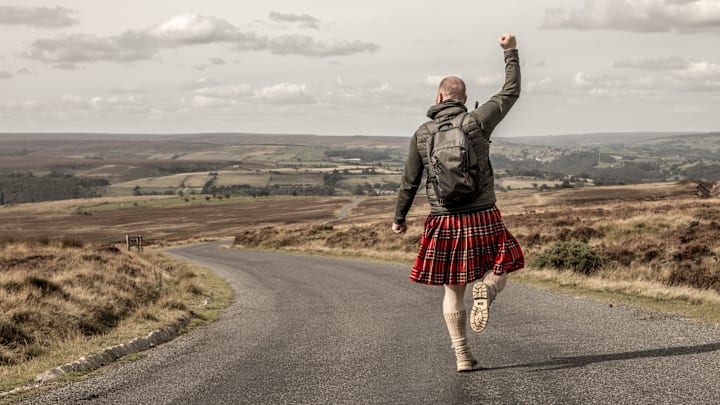At the behest of England’s national Anglican church, 1688’s Glorious Revolution—also called the Bloodless Revolution—deposed the country’s last Catholic king. It is widely considered Britain’s first step toward parliamentary democracy. It is less known, however, for setting the table for a kingdom-wide kilt ban decades later.
Dressed for Battle
That year, King James II (he was also James VII of Scotland) became the proud papa of a baby boy—and England’s parliament was not happy about it. James was Roman Catholic, a deeply unpopular religion, and the birth of his son secured a Catholic lineage that, in the opinion of England’s Anglican parliament, guaranteed a future of religious tyranny. To stop this, the establishment pushed James off the throne and handed the seat to his Protestant daughter and son-in-law, Mary and William of Orange (who ruled jointly as William and Mary). Over the next 60 years, a series of bloody uprisings ensued as James’s supporters, called Jacobites, attempted to restore their anointed Catholic king back to the big chair. Many of these supporters were Scottish.

Scottish Jacobite armies regularly went to battle wearing tartan kilts. A staple of Highland dress dating to the early 16th century, these outfits didn’t resemble the skirt-like kilts we’re familiar with today; rather, these kilts were 12-yard swaths of cloth that could be draped around the body. The garment, which could be looped and knotted to create different outfits to accommodate the fickle Highland weather, was part of a practical workman’s wardrobe. As the politician Duncan Forbes wrote in 1746, “The garb is certainly very loose, and fits men inured to it to go through great fatigues, to make very quick marches, to bear out against the inclemency of the weather, to wade through rivers, and shelter in huts, woods, and rocks upon occasion; which men dressed in the low country garb could not possibly endure.”
Because the kilt was widely used as a battle uniform, the garment soon acquired a new function—as a symbol of Scottish dissent. So shortly after the Jacobites lost their nearly 60-year-long rebellion at the decisive Battle of Culloden in 1746, England instituted an act that made tartan and kilts illegal:
“That from and after the first day of August, One thousand, seven hundred and forty-six, no man or boy within that part of Britain called Scotland, other than such as shall be employed as Officers and Soldiers in His Majesty’s Forces, shall, on any pretext whatever, wear or put on the clothes commonly called Highland clothes (that is to say) the Plaid, Philabeg, or little Kilt, Trowse, Shoulder-belts, or any part whatever of what peculiarly belongs to the Highland Garb; and that no tartan or party-coloured plaid of stuff shall be used for Great Coats or upper coats.”
Punishment was severe: For the first offense, a kilt-wearer could be imprisoned for six months without bail. On the second offense, he was “to be transported to any of His Majesty’s plantations beyond the seas, there to remain for the spaces of seven years.”
A Symbol Sticks
The law worked … mostly. The tartan faded from everyday use, but its significance as a symbol of Scottish identity increased. During the ban, it became fashionable for resistors to wear kilts in protest. As Colonel David Stewart recounted in his 1822 book, many of them worked around the law by wearing non-plaid kilts. Some found another loophole, noting that the law never “specified on what part of the body the breeches were to be worn” and “often suspended [kilts] over their shoulders upon their sticks.” Others sewed the center of their kilt between their thighs, creating a baggy trouser that must have resembled an olde timey predecessor to Hammer pants.
According to Sir John Scott Keltie’s 1875 book A History of the Scottish Highlands, “Instead of eradicating their national spirit, and assimilating them in all respects with the Lowland population, it rather intensified that spirit and their determination to preserve themselves a separate and peculiar people, besides throwing in their way an additional and unnecessary temptation to break the laws.”

By 1782, any fear of a Scottish uprising had fallen and the British government lifted the 35-year-old ban. Delivering a royal assent, a representative of Parliament declared: “You are no longer bound down to the unmanly dress of the Lowlander.”
But by that point, kilts and tartan were no longer staples of an ordinary Scottish laborer’s wardrobe. In that sense, the law had done its job. But it also had an unintended consequence: It turned the tartan into a potent symbol of Scottish individuality and patriotism. So when the law was lifted, an embrace of kilts and tartan blossomed—not as everyday work clothes, but as the symbolic ceremonial dress that we know today. The law, which was intended to kill the kilt, very well might have helped saved it.
Discover More Stories About Scotland:
A version of this story originally ran in 2018; it has been updated for 2025.
